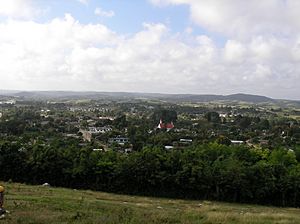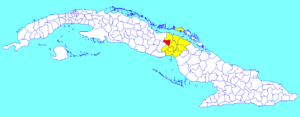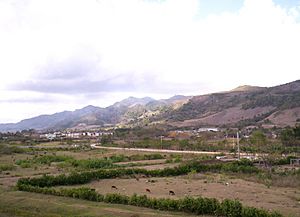Florencia, Cuba facts for kids
Quick facts for kids
Florencia
|
|
|---|---|
 |
|

Florencia municipality (red) within
Ciego de Ávila Province (yellow) and Cuba |
|
| Country | Cuba |
| Province | Ciego de Ávila |
| Area | |
| • Total | 286 km2 (110 sq mi) |
| Elevation | 110 m (360 ft) |
| Population
(2022)
|
|
| • Total | 18,291 |
| • Density | 63.95/km2 (165.64/sq mi) |
| Time zone | UTC-5 (EST) |
| Area code(s) | +53-336 |
| Website | https://www.florencia.gob.cu/es/ |
Florencia (pronounced flo-REN-see-ah) is a town and municipality in the Ciego de Ávila Province of Cuba. It is located in the western part of the province, south of Chambas. In 1976, Florencia became its own municipality. Before that, it was made up of smaller areas like Guadalupe, Tamarindo, and Marroquí, which were part of the Morón municipality.
Contents
Discovering Florencia's Landscape
Florencia is a mountain region with many rivers, thick forests, and cool caves. Some caves even have rivers flowing underground! In 1991, a huge water system called "Liberación de Florencia" was built here. It was named after the area because it was the first place taken by local revolutionary forces in the province of Camagüey on December 14, 1958.
This amazing water system is in the green valleys of Florencia and Tamarindo. It adds to the natural beauty of this Cuban area. Unlike most other towns in this province, Florencia's economy mainly relies on growing tobacco.
Florencia is also the main town where the local government is located. It is the biggest city in the municipality, with about 7,000 people living there. Other smaller towns nearby include Tamarindo, Las Pojas, Lowrey, Guadalupe, and Marroquí.
A Look Back: Florencia's History
In the 1920s, the Norte de Cuba railroad opened. It connected the cities of Santa Clara and Puerto Tarafa. Florencia started to grow when a train station was built in 1926. This station helped people from Guadalupe, which is the oldest town in the region. The station was built on a farm called El Merino.
The railroad was super important for this area. It was the first way to connect these isolated valleys with the rest of Cuba. Before the train, roads were almost nonexistent. People traveled mostly by arreas (mules). When the railroad arrived, farmers became wealthier. Many merchants and business people moved their companies closer to the new station.
Local farm owners and real estate companies started to develop the town. First, the train station, and then the new town itself, were named Florencia. A neighbor suggested the name. She said the mountains reminded her of the mountains near Florence in Italy.
The town grew quickly in the 1940s. This was partly because Sansó & Cia opened a large food factory. Also, dams were built on the Chambas River. When the water from these dams flooded the Florencia and Tamarindo valleys in the 1990s, many affected farmers and their families moved to Florencia. Florencia kept growing and became an important center for culture and business. It also got better communication systems.
Before 1976, Florencia was part of the Morón municipality. Then, Morón was divided into six new municipalities in the new Ciego de Avila province. This change gave people a new identity. People from Florencia became known as Florencianos.
Exploring Florencia's Geography
Florencia is located in the northwest part of the Ciego de Ávila Province in Cuba. The Chambas River flows through the Florencia, Guadalupe, and Tamarindo valleys. The "Liberation of Florencia" Dams on this river cover large parts of these valleys.
The valleys are surrounded by hills that are part of the Central Cordillera. This is one of the three main mountain systems on the island. These high hills separate Florencia from the rest of the province. The other parts of the province are mostly flat and have different natural features.
To the northwest, the North Jatibonico River joins the Jatibonico Sierra. This area has a beautiful system of caves, rich forests, and diverse animals. This special place is known as Boqueron.
Boqueron is a National Natural Reserve. It has a camping area and is home to the Florencia Hipic Center. Between Boqueron and Florencia Valley is El Merino Hill. This is the highest peak of the Jatibonico Sierra, standing at 396.6 meters (about 1,301 feet) above sea level. You can see El Merino Hill from almost anywhere in the town.
Life in Florencia: Culture and Economy
The main way people make a living in Florencia is through farming. Growing tobacco is the most important crop. Other important activities include making canned food, growing vegetables and fruits, and raising livestock.
The culture of Florencia mostly comes from its country areas. Many different groups of people have lived here, especially those who moved from the Canary Islands in the late 1800s and early 1900s. A very popular art form in Florencia is La Décima. This is a type of poem with 10 syllables, often sung. In 1968, the Primer Taller Literario Decimista de Cuba (First Decimista Literary symposium of Cuba) was started in Florencia by humble country people.
People in Florencia are very proud of their traditions and celebrations. Some of the most important events are:
- Spending Saturday nights at parrandas güajiras (Cuban country music parties).
- Celebrating "14 de Diciembre, los Pinos" (pine tree).
- Remembering Isabel Victoria, who was the first teacher and helped a lot with public works in Florencia.
- Honoring Lucas Buchillon, a local poet.
- The election of La Flor de Virama (the tobacco flower), which is like a Miss Florencia contest.
- The Carnaval Star contest.
- In Tamarindo, the celebration on January 28th is very important.
All these events are celebrated as lively street parties, which are common in Cuba.
Florencia also has many cultural places. These include the Florencia Municipal Museum, which has a great collection of items from ancient Cuban people found near the Chambas River. There's also the Casa de la Cultura (cultural house) and the Municipal Library.
Boqueron, a National Natural Reserve, is about 4 kilometers (2.5 miles) west of Florencia city. It's a popular place for tourists from the local area, Cuba, and other countries. This natural reserve has caves, rivers, and lots of different plants and animals. The "Hipic Center of Florencia" in Boqueron, along with fishing at the "Liberación" Dam, are the most popular tourist activities.
Who Lives in Florencia?
In 2004, the municipality of Florencia had about 19,811 people. It covers an area of 286 square kilometers (about 110 square miles). This means there were about 69 people per square kilometer.
Recently, Florencia's population has been shrinking a little. In 2004, the population growth was -4.59. The number of people went down from 19,856 in 2002 to 19,765 in 2004. This is interesting because the Ciego de Avila province usually has one of the highest population growths in Cuba. In 2022, the population was 18,291.
Famous People from Florencia
- Omar Carrero is one of the most important pitchers in the history of the Cuban Baseball Team. He was named the most valuable player in 1976 in the Cuban National Series. He was born and grew up in the village of Lowrey, where his family still lives.
- Jaime Sarusky is a writer and journalist. In 2004, he won the National Literary Award. One of his most famous books is The Ghost Of Omaja (1986).
See also
 In Spanish: Florencia (Cuba) para niños
In Spanish: Florencia (Cuba) para niños



